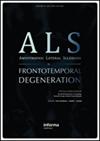Identifying behavioural changes in ALS: Validation of the Beaumont Behavioural Inventory (BBI)
IF 2.8
4区 医学
Q2 CLINICAL NEUROLOGY
Amyotrophic Lateral Sclerosis and Frontotemporal Degeneration
Pub Date : 2017-01-02
DOI:10.1080/21678421.2016.1248976
引用次数: 64
Abstract
Abstract Objective: Behavioural changes are an important part of amyotrophic lateral sclerosis (ALS). However, most tools do not account for the influence of motor impairment. Furthermore, they do not fully measure the broad range of behavioural changes specific to ALS. This study aimed to develop and validate an ALS specific behavioural inventory, the Beaumont Behavioural Inventory (BBI). Methods: The BBI was validated in a cohort of ALS patients (n = 85) and 78 age-, gender-, and education-matched controls. The scale was validated against the Frontal Systems Behaviour Scale (FrSBe) and The Frontal Assessment Battery (FAB) for convergent validity, and against other non-behavioural measures to assess discriminant validity. Reliability was assessed with Cronbach's alpha. Results: The instrument showed high internal consistency (Cronbach’s alpha value =0.891). BBI scores highly correlated with the FrSBe and moderately with the FAB. However, the measure was independent from non-behavioural measures. Using a cut-off score of 7 for mild behavioural changes, the BBI displayed high sensitivity and specificity (87.9% and 78.85%, respectively). The cut-off score for moderate changes, consistent with a diagnosis of ALS-FTD, is set at 22.5, showing 90% sensitivity and 96% specificity. Discussion: The BBI is a sensitive and specific tool to assess the entire behavioural spectrum of ALS.识别ALS的行为变化:博蒙特行为量表(BBI)的验证
摘要目的:行为改变是肌萎缩侧索硬化症(ALS)的重要组成部分。然而,大多数工具并没有考虑到运动损伤的影响。此外,他们并没有完全衡量ALS特有的广泛行为变化。本研究旨在开发和验证ALS特有的行为量表,即博蒙特行为量表(BBI)。方法:在一组ALS患者(n = 85)和78个年龄、性别和教育程度匹配的对照组。该量表根据正面系统行为量表(FrSBe)和正面评估组(FAB)进行收敛有效性验证,并根据其他非行为测量进行判别有效性评估。可靠性用Cronbachα进行评估。结果:该仪器显示出高度的内部一致性(Cronbachα值=0.891)。BBI评分与FrSBe高度相关,与FAB中度相关。然而,该措施独立于非行为措施。对于轻度行为变化,使用7分的分界点,BBI显示出高灵敏度和特异性(分别为87.9%和78.85%)。中度变化的临界分与ALS-FTD的诊断一致,设定为22.5,显示出90%的敏感性和96%的特异性。讨论:BBI是一种敏感而具体的工具,用于评估ALS的整个行为谱。
本文章由计算机程序翻译,如有差异,请以英文原文为准。
求助全文
约1分钟内获得全文
求助全文
来源期刊

Amyotrophic Lateral Sclerosis and Frontotemporal Degeneration
CLINICAL NEUROLOGY-
CiteScore
5.40
自引率
10.70%
发文量
64
期刊介绍:
Amyotrophic Lateral Sclerosis and Frontotemporal Degeneration is an exciting new initiative. It represents a timely expansion of the journal Amyotrophic Lateral Sclerosis in response to the clinical, imaging pathological and genetic overlap between ALS and frontotemporal dementia. The expanded journal provides outstanding coverage of research in a wide range of issues related to motor neuron diseases, especially ALS (Lou Gehrig’s disease) and cognitive decline associated with frontotemporal degeneration. The journal also covers related disorders of the neuroaxis when relevant to these core conditions.
 求助内容:
求助内容: 应助结果提醒方式:
应助结果提醒方式:


